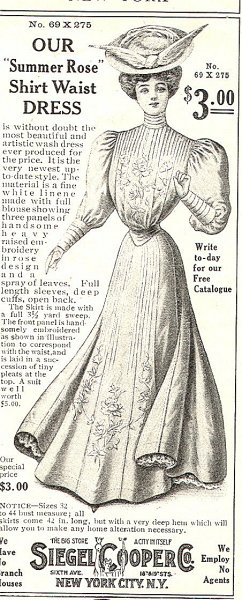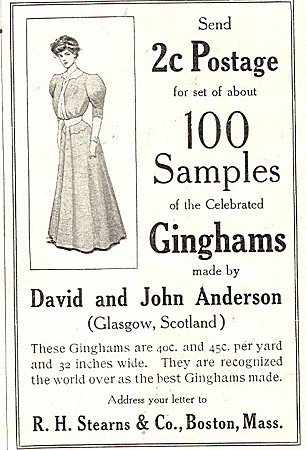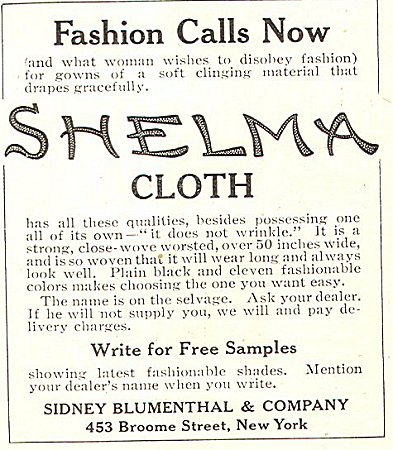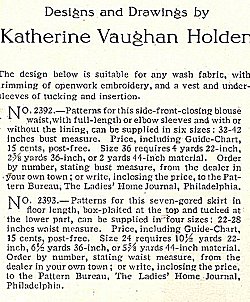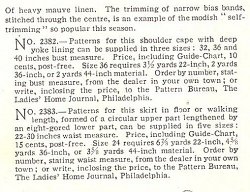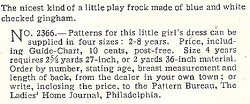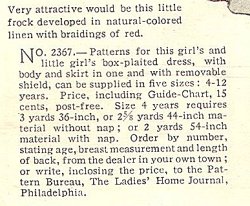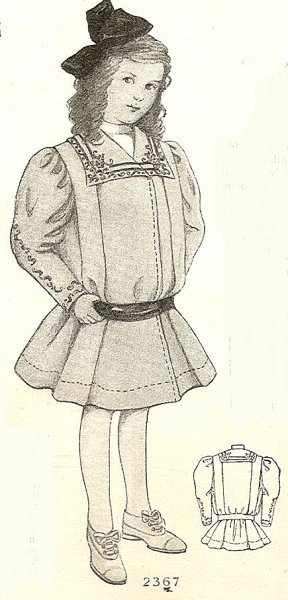| Space HERE for your Family scrapbook housekeeping clippings.
Just type it up and send in email or Word document. Be sure to say your name and
state and who you got the antique clipping from. If you can date the clipping,
even approximately, that will be nice, too. This page will be up to your
initiative. |
 |
In times past, just as now, many recipes and housekeeping ideas were
copied from magazines and passed around among friends and family.
They became part of the family's traditions in that way. These
clippings are from the scrapbook of my Grandmother, Mildred Mudge
[1895-1925] and were pasted in with a heading
Care
of Clothing.
Her
scrapbook also includes
recipes,
care of the sick, and stories of interest. I will present more of
these and you are very welcome to submit items on the subject from
scrapbooks you may have. Tell who saved them and the date as close
as you can.
 |
These items are included here to help us understand the lifestyle and duties
of our predecessors. Your female ancestors, regardless of their individual
talents and interests, were engaged in housekeeping. They did not have the
career choices then that we have now, and they did not have the conveniences in
food preparation and household functions that we take for granted. They had no
dishwashers, vacuum cleaners, etc. They cooked on a wood stove. They did
everything themselves with only their own "elbow grease" and tools far more
primitive than those we use. Their household management duties were full time
and more and left little time or energy for much else. They relied on magazines
and newspapers and each other for recipes and tips on household matters.
This scrapbook that my grandmother compiled serves as a recipe book and book
of household tips. She made it herself from an old Agrucultural Manual.
Clippings were pasted on pages, and some book pages were cut out to moderate the
book's thickness. Nothing was wasted or discarded before its usefulness was
fully exhausted. |
| My grandmother died of a brain tumor when my father was just a very small
child. It is only through the scrapbooks, letters and notebooks that Mildred
left behind that I am able to know her and the world in which she lived. Had she
lived in a different time and place, she would most certainly have been a
writer. She had an active mind and a variety of interests. She was systematic,
methodical, an organizer. Some of the clippings in the scrapbooks have
illustrations which she colored. I'll include a few here.
Tips for Care of Antique Clothing Items at
http://www.vintagevixen.com/articlesCare/washOrNot.asp |
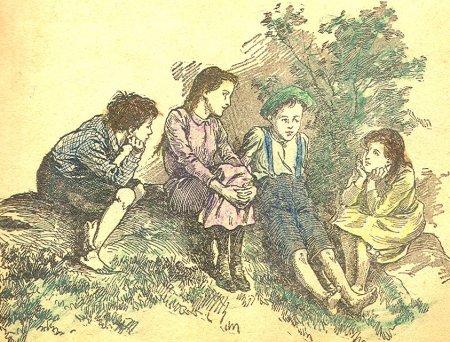 |
|
|
Joyce's Search Tip - January 2008
 |
Do You Know that you can search just the
articles on the site by using the Articles button in the Partitioned
search engine at the bottom of the Current
What's New Page? . |
|
|
Care of Clothes.
We all know how soon the men's suits begin to lose their new look after a
while. Sometimes they are caught in a shower or perhaps are
carelessly thrown across a chair and left to be discovered by the
busy housewife, a mass of unsightly wrinkles. Now I think a farmer
looks just as nice in a nicely pressed suit as his city brother and
I will tell you how to press them to look new and stay so for a long
time. First brush carefully and clean or remove spots or shiny look
with alcohol. Lay the trousers in the original crease. Dampen a
clean white cloth and lay this over them and press with a hot iron
until the cloth is quite dry; repeat this process on both sides of
seams - that is, both sides of trouser legs. Do coat sleeves and
lapels same way and press back and front of coat very carefully, the
crease being laid on seam under the arms. Clothes carefully brushed
and pressed wear twice longer and look ever so much better also.
--Amelia Reisacher, Montgomery, Co., Ill.
How Last Season's Clothes Can Be Made to Renew Their Youth
Though it is difficult to give general advice in the matter of economy in
clothes, there are a number of timely hints that may save every one a bit of
money here or there. The last year's suit, for instance, need not be
delegated to the charity bundle, no matter how shabby it may seem in the glare
of the bright spring sunshine. If it is shiny at the elbows or across the
shoulders at the back, the nap can be restored by a gentle application of emery
paper and a soft brush. Spots can be removed with diluted ammonia and
calcined magnesia, or, in the case of alpaca or mohair, pure white soap and
lukewarm water will work wonders. If the collars, pocket flaps and lapels
are frayed at the edges, that may be covered with moiré of ottoman silk in a
color to match the suit, or bordered with one of the new gallons with silver,
gold and Persian designs. If the buttons that are losing their cloth
covering are replaced at the same time with bone or mother-of-pearl buttons, the
jacket of the suit will look as good as new. As for the skirt, if the hem
is frayed it may be cut off and replaced with one of the same silk that is to
refurbish the collar and cuffs. A stitched belt of the same silk completes
the costume. If the lace or net yokes and cuffs of silk waists have a worn
and ancient look about them, they may be veiled in chiffon most effectively.
In fact, whole waists of lace or all-over net that has done good service may
still be retained in the wardrobe if covered with one of those chic little
overblouses of chiffon or gauze made in the approved peasant style. Such a
bodice, worn with a messaline or a silk crepe skirt, makes a charming costume
for afternoon and dressy wear. Lingerie waists, or even tailored ones,
that have become a little "overworn" around the neckband and at the cuffs may be
made to serve many another day if these parts are cut off and the raw edges
finished neatly with bias bands and Chanteeler frills.
This is the season for using old pieces of lace to garnish new frocks and
old. Chemisettes and cuffs, tunics, flounces, hats, everything may
be touched up with a pretty bit of lace. Though Chantilly is the prime
favorite, none of the others may be said to be out of fashion, save perhaps the
heavier Renaissance. As for hats, if one does not wish to trust them to a
hatter to clean and reblock (for they have a way of making them unrecognizable),
one may well do it at home with the aid of a little oxalic acid, plain sugar
water or gum Arabic. The oxalic acid is for cleaning purposes.
Applied vigorously with a stiff brush, and then thoroughly rinsed with cold
water, it will work wonders. If the hat is to have a new shape, it should
be dipped into hot water, which will make it soft and pliable. It may then
be moulded into any shape with deft hands, turned up or down, stretched or
fluted, and laid out in the sun to dry and harden into its new form. If a
generous amount of sugar is put into the water, or a little gum Arabic, the
stiffness of the hat will be insured. Laces and nets may be stiffened in
the same manner. If one wishes to make a mushroom hat out of a straight or
an upturned sailor - and this is a wonderful secret - the hat may be placed in a
deep bowl or wash basin when wet and left there to dry. When it is dry it
will have assumed the proper bowl-like contour! Velvet ribbon, if one has
not a steamer attachment for the teakettle, may be refreshed by wetting it on
the reverse side and drawing it quickly across the flat surface of a hot iron.
Velvet may be mirrored by being pressed on the right side and under a layer of
tissue paper. Silk ribbon should be pressed when only slightly moist.
If it is too damp the ironing will stiffen it. Women who are clever with
their paint brushes can freshen up flowers like the morning dew. Last
year's wreath or garland may serve another season beneath a cloud of tulle or
net, or in a closely tied cluster in which the individual blossom does not show
prominently.
Some Hints for Work Dresses
To the Editor of the Tribune Farmer.
Sir: Perhaps some of your readers have not yet finished their spring
sewing, and here are a few hints worth trying. Tier aprons cut by a simple
and reliable 10-cent pattern which is in only a few pieces and quickly put
together are just the things for hot weather wear about your ironing, baking,
etc. I make mine with elbow sleeves and round or Dutch collar, and wear
them without dresses or with odd wash skirts and no waists. They are
easier to launder than wrappers and much cooler and neater. I am also
making some pretty shirtwaists in colors to wear out some odd skirts with.
I shall make them with narrow neckbands having buttonholes worked in them for
collar buttons, and I shall wear white collars - either standing or Dutch - with
them. They are so much prettier than white for common unless one has
unlimited time for laundering. When making house dresses, if an inch wide
straight strip of the goods is stitched over the gathers at the waist line it is
an easy matter to keep waist and skirt from parting company as they often do.
Sew a few buttons to the before mentioned strip, put corresponding buttonholes
in the skirt band and the thing is done. They need not be unbuttoned
except when they are washed if the skirt opens at the side front, as is usually
the case. Wear a belt like the dress and finish the neck with a round
turnover collar, and you will look as neat as the proverbial "new pin."
Wearing a Hip Pad.
It is unsightly to see an improperly adjusted pad worn beneath the skirts.
But many women to wear the small triple pad, and when gathered petticoats are
placed over it, the skirt is lifted and bulges over the band, frequently
destroying the good effect which can be produced with a flat pad. The only
proper manner to wear one is to place it beneath the corset, lacing it to the
body. Avoid gathered skirts unless very slender, and have all
undergarments neatly arranged over the hips.
Wear Your Clothes Well.
Study to wear your clothes well. The ability to wear clothes is the
difference between women. That is the reason why, sometimes, the girl who
stands behind the counter in the dry goods store is more stylish in appearance
in her inexpensive dress than many of her wealthy customers in their rich gowns.
The sales girls, not all of them but many of them, have learned the secret of a
good appearance - that to wear one's clothes with dignity and becomingness is
the real secret of being a good dresser.
Ladies Home Journal - May 1906 - Advertisements
From Joyce's Museum |
 |
Sewing Machine and Clothing Advertisements
Fabric [Yard Goods} Advertisements
Patterns by Category - These are from pages where
several patterns are shown. I have selected one from each category.
You can see this entire beautiful magazine, and others of the
period, at my museum.
| For Girls 14 to 18 |
Description |
For Girls 18 to 20 |
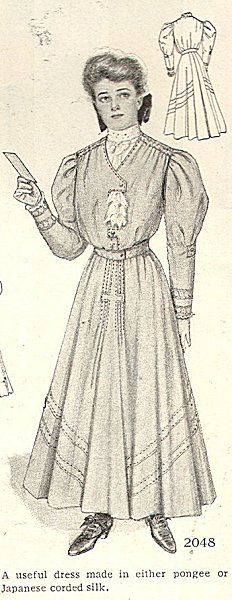
|
|
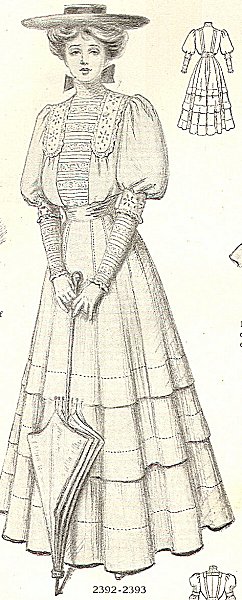 |
| Styles Suitable for Summer Clothing |
|
Summer Gowns for the Street |
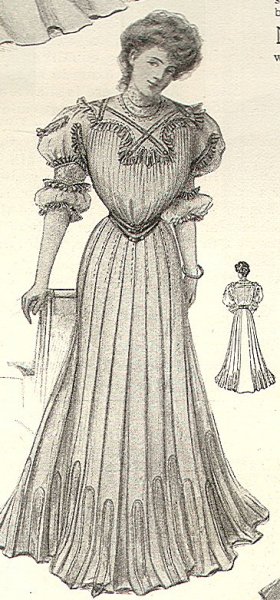 |
|
 |
|
Tub Frocks for Little Girls
|
|
|





